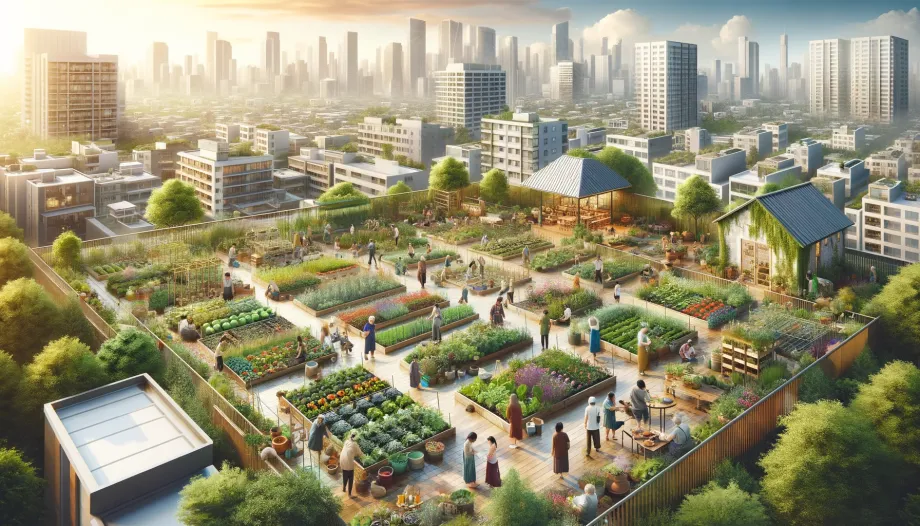This post may contain affiliate links. If you buy something from one of our links we may earn a commission. Thanks

Discover the array of rooftop gardening benefits in our comprehensive guide. From enhancing air quality to creating an urban oasis, learn how these gardens transform city living.
Rooftop Gardening Benefits Key Takeaways:
- Rooftop gardening benefits include improving air quality, mitigating urban heat island effects, managing stormwater, enhancing biodiversity, and boosting energy efficiency.
- These gardens also offer psychological benefits, foster community engagement, and can increase property values.
Welcome to the vibrant world of rooftop gardening! Here, the rooftop gardening benefits are not just about adding splashes of green to concrete vistas but about revolutionizing urban living.
Learn more about rooftop gardens and join us as we delve into how these elevated green spaces breathe life into our cities, offering a blend of ecological, social, and aesthetic perks.
Introduction to Rooftop Gardening Benefits
Rooftop gardens, a blossoming trend in urban landscapes, offer a unique blend of environmental and social benefits.
As cities grow denser, these green havens are not just about beautifying the concrete jungle; they are about transforming urban living.
In this comprehensive exploration, we delve into the myriad advantages of rooftop gardens, from enhancing air quality to fostering community bonds.
Whether it’s atop a bustling commercial hub or a serene residential building, rooftop gardens are redefining our relationship with nature in urban spaces.
A roof garden is a garden on the roof of a building. Besides the decorative benefit, roof plantings may provide food, temperature control, hydrological benefits, architectural enhancement, habitats or corridors for wildlife, recreational opportunities, and in large scale it may even have ecological benefits. The practice of cultivating food on the rooftop of buildings is sometimes referred to as rooftop farming. Rooftop farming is usually done using green roof, hydroponics, aeroponics or air-dynaponics systems or container gardens. Wikipedia
Part 1: Environmental and Ecological Benefits
Dive into the heart of rooftop gardening with our exploration of its Environmental and Ecological Benefits.
This section unveils how these green rooftops serve as more than just charming gardens. The environmental benefits of rooftop gardens and the impact of green roofs are manifold.
They’re pivotal in enhancing air quality, cooling urban landscapes, and nurturing biodiversity. Join us to uncover the transformative impact these gardens have on our environment and ecosystems.
1. Air Quality Improvement
In the realm of rooftop gardening, Air Quality Improvement stands out as a significant benefit.
This section will illuminate how these elevated green spaces act as natural air purifiers, filtering pollutants and enhancing the breathability of urban atmospheres.
Learn how the simple act of planting on a rooftop can lead to cleaner, healthier air for city dwellers.
2. Filtering Urban Pollutants
- Rooftop gardens serve as natural air purifiers. In the heart of the city, where air quality often suffers, these gardens filter pollutants and smog, providing much-needed respiratory relief.
- By integrating plants that excel in absorbing airborne toxins, rooftop gardens can significantly mitigate air pollution.
3. Carbon Sequestration
- Beyond filtering pollutants, these green spaces are adept at absorbing carbon dioxide.
- Through the process of photosynthesis, rooftop gardens convert CO2 into oxygen, effectively lowering the overall CO2 levels in urban areas and contributing to cleaner air.
4. Urban Heat Island Effect Mitigation
In this segment, we delve into how rooftop gardens play a crucial role in Urban Heat Island Effect Mitigation.
Discover how these verdant spaces combat the heat absorption typical in urban concrete jungles, creating cooler, more comfortable city environments.
We’ll explore the science behind this phenomenon and how rooftop gardens are key to maintaining a balanced urban climate.
5. Natural Cooling
Rooftop gardens tackle the Urban Heat Island (UHI) effect head-on. Cities, with their concrete and asphalt, tend to trap heat.
Rooftop gardens absorb this heat, reducing the temperature in the surrounding areas. This natural cooling is crucial in mitigating the UHI effect, making cities more livable during the hot summer months.
6. Moisture Release
- The plants in these gardens release moisture into the air through evapotranspiration, further aiding in cooling the environment.
- This moisture release creates a refreshing microclimate that can be particularly beneficial during heatwaves.
7. Effective Rainwater Management
Next, we explore the aspect of Effective Rainwater Management in rooftop gardening.
This section highlights how these gardens not only beautify urban spaces but also play a vital role in managing rainwater.
By absorbing and filtering stormwater, rooftop gardens alleviate strain on urban drainage systems, showcasing an innovative approach to dealing with one of the city’s most pressing environmental challenges.
8. Natural Water Absorption
In urban settings, where stormwater management is a challenge, rooftop gardens offer a solution.
They absorb rainwater, thus easing the burden on city drainage systems.
This absorption prevents the rainwater from rapidly flowing into streets and potentially causing urban flooding.
9. Water Filtration
- Rooftop gardens also act as natural water filters. As rainwater passes through the garden, it gets purified by the plants and soil.
- This filtration process reduces the amount of pollutants entering water bodies, thereby protecting local aquatic ecosystems.
10. Energy Efficiency and Conservation
In the next section, we focus on the role of rooftop gardens in Energy Efficiency and Conservation.
Here, we’ll uncover how these urban oases not only enhance aesthetics but also contribute significantly to energy savings.
From reducing heating and cooling needs to providing natural insulation, learn about the ways rooftop gardens are reshaping energy consumption in our urban landscapes.
11. Insulating Properties
- Rooftop gardens enhance a building’s insulation, maintaining indoor temperatures more consistently.
- During winter, they reduce heat loss, while in summer, they keep buildings cooler, reducing the dependence on air conditioning.
12. Reduced Energy Consumption
- The insulating effect of rooftop gardens translates into significant energy savings.
- Buildings with rooftop gardens require less heating in winter and less cooling in summer, leading to lower energy consumption and cost savings.
Enhancing Biodiversity and Wildlife
Now, let’s turn our attention to Enhancing Biodiversity and Wildlife, a vital aspect of rooftop gardening.
This section will reveal how these green spaces not only add beauty to our urban environments but also serve as crucial habitats for a variety of wildlife.
From supporting pollinators to offering refuge for birds, discover the role rooftop gardens play in maintaining and enriching urban biodiversity.
13. Habitats for Urban Wildlife
These gardens create pockets of biodiversity in urban areas. They provide habitats for birds, insects, and other urban wildlife, contributing to the ecological balance of the city.
14. Diversity of Plant Life
Rooftop gardens can host a wide range of plant species, some of which may be rare or native to the region.
This diversity not only enhances the aesthetic appeal of the garden but also supports various forms of urban wildlife.
Social, Economic, and Aesthetic Benefits
Here we explore the Social, Economic, and Aesthetic Benefits of rooftop gardening.
This section delves into how these gardens are more than just green patches in the sky; they’re catalysts for community bonding, enhancers of property value, and beautifiers of urban landscapes.
Join us as we uncover the myriad ways rooftop gardens enrich our lives, not just environmentally, but socially and economically as well.
15. Psychological and Health Benefits
The focus on Community Engagement and Social Well-Being is a key aspect of rooftop gardening.
These urban green spaces foster a sense of community and contribute positively to social health.
From communal gardening activities to creating gathering spots for social interaction, rooftop gardens are not just areas of solitude but vibrant platforms for community building and social enrichment in urban landscapes.
In this section, we delve into the Psychological and Health Benefits of rooftop gardening.
Here, you’ll learn how these urban green spaces do more than just beautify; they are sanctuaries for mental wellness and relaxation.
We’ll explore the profound impact that connecting with nature, even in the heart of the city, has on our overall well-being and mental health.
Join us in discovering the therapeutic power of rooftop gardens in urban settings.
16. Enhancing Mental Well-Being
Rooftop gardens are more than just a visual delight; they are sanctuaries for mental well-being.
The serene ambiance and lush greenery provide a peaceful retreat, offering city dwellers a chance to reconnect with nature.
This connection has been shown to reduce stress and promote mental health, making these gardens not just a luxury but a necessity in urban life.
17. Promoting Happiness
- The presence of green spaces has been linked to increased happiness and life satisfaction.
- Rooftop gardens, accessible to residents and workers alike, provide a unique opportunity to enjoy these benefits amidst urban settings.
Community Engagement and Social Well-Being
This section shines a light on Community Engagement and Social Well-Being, fundamental elements in rooftop gardening.
Here, we’ll explore how these gardens serve as communal hubs, bringing together individuals from diverse backgrounds.
These spaces not only offer respite from the urban bustle but also foster social interactions, collaborative projects, and collective learning.
Dive in to discover how rooftop gardens are nurturing communities and enhancing the social fabric of city life.
18. Fostering Community Bonds
- Rooftop gardens are more than just individual retreats; they are communal spaces that encourage social interaction and community engagement.
- These gardens often become hubs for social events, educational workshops, and communal gardening activities, strengthening neighborhood bonds.
19. Educational Opportunities
- They also serve as platforms for learning and sharing knowledge about sustainable living and gardening.
- This educative aspect not only empowers individuals but also fosters a more environmentally conscious community.
Property Value and Urban Aesthetics
Next, we explore the impact of rooftop gardens on Property Value and Urban Aesthetics.
This section delves into how these green retreats in urban settings do more than just refresh the eye. They significantly boost the worth and appeal of properties.
Discover the intricate ways in which these elevated gardens enhance the visual landscape of cities and become a coveted feature for real estate, contributing to the economic and aesthetic upliftment of urban environments.
20. Boosting Property Value
- A rooftop garden is a valuable asset, often leading to an increase in property value.
- The aesthetic and functional benefits of these gardens make properties more attractive to potential buyers and renters, reflecting the real estate market.
21. Enhancing Urban Beauty
- Rooftop gardens contribute significantly to the visual appeal of the urban landscape.
- They transform bland rooftops into lush, green spaces, adding a touch of nature’s beauty to the concrete skyline.
Urban Agriculture and Food Production
In this section, we delve into the role of rooftop gardens in Urban Agriculture and Food Production.
Here, we’ll explore how these gardens are not just ornamental but functional, playing a pivotal role in sustainable urban food systems.
Discover how these spaces are being transformed into productive agricultural plots, offering fresh, local produce amidst the urban sprawl, and contributing to food security in innovative ways.
Join us as we uncover the potential of rooftop gardens to revolutionize how we grow and access food in city landscapes.
22. Local Food Production
- In a time when local and sustainable food production is increasingly important, rooftop gardens offer a practical solution.
- They can be used to grow a variety of crops, providing fresh, locally sourced produce to urban residents.
23. Sustainable Food Practices
These gardens also serve as models for sustainable agriculture practices in urban areas, demonstrating how food can be grown efficiently and responsibly in limited spaces.
Noise Reduction and Improved Acoustic Environment
Now, let’s examine how rooftop gardens contribute to Noise Reduction and Improved Acoustic Environments.
This section will highlight the often-overlooked acoustic benefits of these green spaces.
Rooftop gardens not only create visual appeal but also serve as natural sound barriers, dampening the hustle and bustle of city life.
We’ll explore how the combination of plants, soil, and water features in these gardens effectively absorbs and mitigates urban noise, creating a more tranquil and serene atmosphere for city dwellers.
24. Sound Insulation
Rooftop gardens act as natural sound barriers.
The combination of soil, plants, and water features can significantly reduce noise pollution, creating a quieter and more peaceful environment, especially in busy urban areas.
Economic Benefits of Green Roofs
In this final part of our journey, we explore the Economic Benefits of Green Roofs, a key aspect of rooftop gardening.
Here, we’ll uncover how these verdant spaces do more than just enrich our surroundings but also offer tangible financial advantages.
From reducing energy costs to creating new job opportunities in the green sector, rooftop gardens are proving to be a wise investment for the urban economy.
Discover how these eco-friendly innovations are not only nurturing the environment but also bolstering the economic health of cities.
25. Energy Savings
- The energy-saving benefits of rooftop gardens translate into economic advantages.
- Reduced reliance on heating and cooling systems means lower utility bills, providing financial relief to both residential and commercial building owners.
26. Creating Green Jobs
- The design, installation, and maintenance of rooftop gardens also contribute to the economy by creating new green jobs.
- This sector provides employment opportunities in urban landscaping, horticulture, and environmental conservation.
FAQs on Rooftop Gardening
Rooftop gardens, with their myriad benefits, often raise questions about their implementation, effectiveness, and advantages.
Below are some commonly asked questions to help demystify this green urban trend.
What are some advantages of rooftop gardens?
Rooftop gardens offer several advantages, including improving air quality, reducing the urban heat island effect, managing stormwater, enhancing biodiversity, and increasing energy efficiency.
They also contribute to psychological well-being, and community engagement, and can raise property values.
What are the benefits of a plant roof?
A plant roof, or a green roof, provides environmental benefits like temperature regulation, air purification, and stormwater management.
It also offers economic benefits such as energy savings and increased property value, alongside enhancing the aesthetic appeal of buildings.
What is the main idea of rooftop gardening?
The main idea behind rooftop gardening is to utilize underused roof spaces in urban areas for environmental, social, and economic benefits.
It involves creating green spaces on rooftops to help address urban environmental challenges, such as air pollution and heat islands, while also providing recreational and aesthetic value.
How do rooftop gardens help air quality?
Rooftop gardens help air quality by filtering airborne pollutants and reducing smog.
The plants in these gardens absorb harmful gases like carbon dioxide and release oxygen, thereby improving the overall air quality.
How effective are rooftop gardens?
Rooftop gardens are effective in several ways. They mitigate urban heat islands, improve air and water quality, and increase biodiversity.
They are also effective in enhancing mental health, providing recreational spaces, and contributing to urban agriculture.
Do rooftop gardens clean the air?
Yes, rooftop gardens clean the air. They act as natural air filters by absorbing pollutants and particulate matter.
Through the process of photosynthesis, these gardens also convert carbon dioxide into oxygen, further purifying the air.
Conclusion: Embracing Rooftop Gardening in Urban Development
A Sustainable Future
Rooftop gardens symbolize a step towards a sustainable urban future.
By addressing environmental issues like air pollution and urban heat, while also offering economic and social benefits, these green spaces are more than just aesthetic enhancements.
They are crucial components in the sustainable development of cities.
Widespread Implementation
The widespread implementation of rooftop gardens can significantly transform urban landscapes. By turning underutilized rooftops into vibrant, green spaces, cities can become more resilient, sustainable, and livable.
A Call to Action
This exploration underscores the importance of integrating rooftop gardens into urban planning.
It’s a call to action for city planners, architects, and residents to embrace these green spaces for a healthier, more sustainable urban environment.
Here is a helpful guide: https://sites.saic.edu/greeninitiatives/greenroofs/images/GuidetoRooftopGardening_v2.pdf
Visit my Amazon Influencer Page for videos and gardening products Grow Your Own Garden






